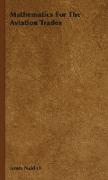- Start
- Mathematics for the Aviation Trades
Mathematics for the Aviation Trades
Angebote / Angebote:
MATHEMATICS FOR THE AVIATION TRADES by JAMES NAIDICH. Originally published in 19I2. PREFACE: This book has been written for students in trade and technical schools who intend to become aviation mechanics. The text has been planned to satisfy the demand on the part of instructors and employers that mechanics engaged in precision work have a thorough knowledge of the funda mentals of arithmetic applied to their trade. No mechanic can work intelligently from blueprints or use measuring tools, such as the steel rule or micrometer, without a knowl edge of these fundamentals. Each new topic is presented as a job, thus stressing the practical aspect of the text. Most jobs can be covered in one lesson. However, the interests and ability of the group will in the last analysis determine the rate of progress. Part I is entitled A Review of Fundamentals for the Airplane Mechanic. The author has found through actual experience that mechanics and trade-school students often have an inadequate knowledge of a great many of the points covered in this part of the book. This review will serve to consolidate the students information, to reteach what he may have forgotten, to review what he knows, and to provide drill in order to establish firmly the basic essentials. Fractions, decimals, perimeter, area, angles, construc tion, and graphic representation are covered rapidly but systematically. For the work in this section two tools are needed. First, a steel rule graduated in thirty-seconds and sixty - fourths is indispensable. It is advisable to have, in addition, an ordinary ruler graduated in eighths and sixteenths. Second, measurement of angles makes a protractor necessary. vi Preface Parts II, III, and IV deal with specific aspects of the work that an aviation mechanic may encounter. The airplane and its wing, the strength of aircraft materials, and the math ematics associated with the aircraft engine are treated as separate units. All the mathematical background required for this work is covered in the first part of the book. Part V contains 100 review examples taken from airplane shop blueprints, aircraft-engine instruction booklets, air plane supply catalogues, aircraft directories, and other trade literature. The airplane and its engine are treated as a unit, and various items learned in other parts of the text are coordinated here. Related trade information is closely interwoven with the mathematics involved. Throughout the text real aircraft data are used. Wherever possible, photographs and tracings of the airplanes mentioned are shown so that the student realizes he is dealing with subject matter valuable not only as drill but worth remembering as trade information in his elected vocation. This book obviously does not present all the mathematics required by future aeronautical engineers. All mathe matical material which could not be adequately handled by elementary arithmetic was omitted. The author believes, however, that the student who masters the material included in this text will have a solid foundation of the type of mathematics needed by the aviation mechanic. Grateful acknowledgment is made to Elliot V. Noska, principal of the Manhattan High School of Aviation Trades for his encouragement and many constructive suggestions, and to the members of the faculty for their assistance in the preparation of this text. The author is also especially indebted to Aviation magazine for permission to use numerous photographs of airplanes and airplane parts throughout the text. JAMES NAIDICH.
Folgt in ca. 15 Arbeitstagen
